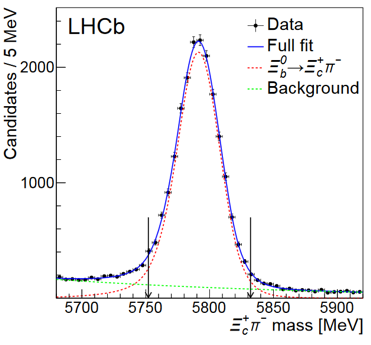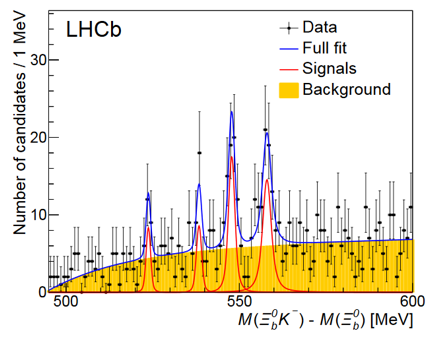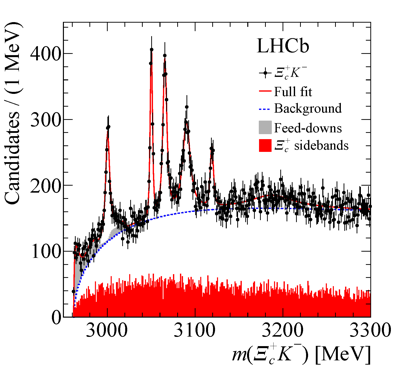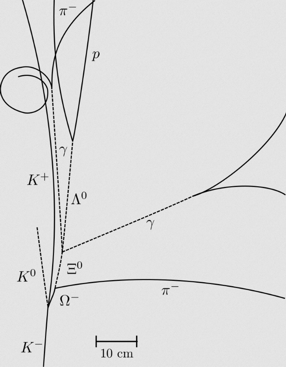First observation of excited Ωb– states.
Today, the LHCb collaboration submitted a paper reporting a new system of four particles interpreted as four narrow excited Ωb– states.
As in many particle physics analyses, the LHCb physicists had to sift through a large amount of data, piecing together particles detected by their experiment (in this case protons, kaons, and pions) and looking for the signature left by the decay of a heavier particle. They first reconstructed a highly pure sample of beauty baryons Ξb0 via their decays into a charmed baryon Ξc+ and a pion π– as seen in the left image below. The red peaking distribution shows the Ξb0 contribution above the background indicated by the green dashed line. The Ξc+ baryons were identified through their decays into a proton p, a kaon K– and a pion π+.
The next step was to combine the Ξb0 baryons with K– mesons present in the same event. The difference between the mass of the Ξb0K– pair and the mass of the Ξb0 alone is shown in the right image above, revealing four narrow structures. They correspond to Ξb0K– masses significantly heavier than the ground state of the Ωb– baryon, which was discovered a decade ago at the Tevatron. The discoveries announced today are interpreted as excited states of the Ωb– baryon. These states are named the Ωb(6316)–, Ωb(6330)–, Ωb(6340)– and Ωb(6350)–, where the numbers indicate their approximate masses in MeV as measured by LHCb. These narrow peaking structures have local significances ranging from 3.6 to 7.2 standard deviations.
LHCb physicists discovered in 2017 in a similar way five excited states of the Ωc0 baryon in the Ξc+K– invariant mass spectrum, shown in the image to the left.
The Ωb– and Ωc0 baryons are higher mass partners of the Ω– baryon, a particle that played a very important role in the history of particle physics. In the 1950s, many different particles were discovered. While initially thought to be elementary, the ever-growing list of discoveries led physicists to doubt this assumption. Therefore efforts were made to find a classification scheme in analogy to the periodic table of chemical elements. The most successful such scheme was proposed by Gell-Mann. In this model, mesons and spin 1⁄2 baryons are organized into octets (referred to as the Eightfold Way), while spin 3⁄2 baryons form a decuplet, as displayed in the left image below. When the scheme was proposed, the top-most particle in the image, the Ω–, was not yet discovered, but hypothesised to exist in order to complete the pattern. The regular structure of the decuplet enabled many properties of this new particle to be predicted, including its mass. The Ω– was subsequently discovered through a single famous bubble-chamber photograph obtained at the Brookhaven laboratory in 1964 (the corresponding line diagram is shown in the right picture below). This picture validated the Eightfold Way, and led Gell-Mann to propose the quark model in 1964, which explains the structure of the octets and decuplet. In the quark model the Ω– is composed of three strange quarks (sss). The Ωc0 and Ωb– have a similar structure to the Ω–, but contain a charm (c) or a beauty (b) quark in place of one of the strange quarks (Ωc0, css; Ωb–, bss).
By discovering the Ωb– and Ωc0 excited state systems, LHCb has reinforced the exceptional role of the Ω baryon family in the history of particle physics. The discovery of these systems will provide important experimental input to constrain models used to describe the structure of baryons containing heavy flavor. In particular, a number of different theories were proposed to explain the five narrow Ωc0 excitations, including models of molecular and pentaquark states. These theories can now be tested by comparing their predictions for the Ωb– system against these new LHCb measurements.
Read more in the LHCb paper and in the CERN Courier article.





